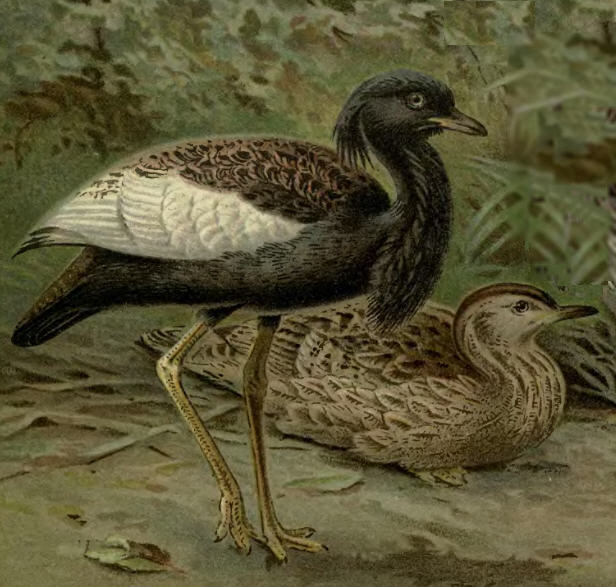- Bengal Florican
Taxobox
name = Bengal Florican

image_width = 220px
image_caption = Male (standing) and female
status = CR
status_system = iucn3.1
regnum =Animal ia
phylum =Chordata
classis =Aves
ordo =Gruiformes
familia =Otididae
genus = "Houbaropsis"
genus_authority = Sharpe,1893
species = "H. bengalensis"
binomial = "Houbaropsis bengalensis"
binomial_authority = (Gmelin,1789 )
synonyms = "Eupodotis bengalensis"
The Bengal Florican, "Houbaropsis bengalensis", is a
bustard , the only member of the genus "Houbaropsis". It has two disjunct populations, one in theIndian subcontinent , another inSouth East Asia . The former occurs fromUttar Pradesh ,India , through theterai ofNepal , toAssam (where it is called "Ulu Mora") andArunachal Pradesh , India, and historically toBangladesh . The South East Asian population occurs inCambodia and adjacent southernVietnam .The male has black feathers running from head to neck and underparts. The dorsal side is buff with fine black vermiculations and black arrowhead markings, and it has a conspicuous white patch on the wing coverts. Females are larger than the male and have a buff brown colour, with a dark brown crown and narrow dark streak down the side of the neck.
They are normally silent but when disturbed utters a metallic "chik-chik-chik" call.
They are usually seen in the early mornings and evenings and are easily spotted in the breeding season of March to August. They live in open tall grassland habitats with scattered bushes. [Grimmett "et al." (1998)]
The population is declining dramatically and only survives in small, highly fragmented populations (220-280 birds in India and up to 100 in Nepal). Consequently, it is uplisted from Endangered to Critically Endangered status in the 2007
IUCN Red List . [See BirdLife International (2007a,b).]The government of Cambodia has taken a significant step towards protecting important habitat for the Bengal Florican. In an effort to save this endangered flagship species from extinction, more than one hundred miles of grassland habitat is to be set aside as integrated farming and biodiversity areas.Restricted to tiny fragments of grassland scattered across Cambodia, Nepal and India, the Bengal Florican, the world's rarest bustard, is known to have become increasingly threatened by land conversion for intensive agriculture, particularly from dry season rice production.
A survey carried out in April-May 2007 in Bardia and Chitwan National Parks and Suklaphanta Wildlife Reserve of Nepal aimed to determine status, distribution and population change. The methods involved counting of lekking sites and identification of territories. A total of 8-9 males and 2 females at Suklaphanta, 1-2 males at Bardia and 5-7 males at Chitwan were recorded. Compared to past studies, the population has declined by 56% since 1982 and by 30% since 2001. [See Forestry Nepal 2008.]
Footnotes
References
*|year=2004|id=40235|title=Houbaropsis bengalensis|downloaded=09 May 2006
* (2007a): [ [http://www.birdlife.org/action/science/species/global_species_programme/whats_new.html 2006-2007 Red List status changes] ] . Retrieved 2007-AUG-26.
* (2007b): [http://www.birdlife.org/datazone/search/species_search.html?action=SpcHTMDetails.asp&sid=2782&m=0 Bengal Florican - BirdLife Species Factsheet] . Retrieved 2007-MAY-22.
* (1998): "Birds of the Indian Subcontinent". Christopher Helm, London. ISBN 0713640049
* (2008): [http://www.forestrynepal.org/article/laxman-prasad-poudyal/2869 The Decline of Bengal Florican Houbaropsis bengalensis in Nepal] .
Wikimedia Foundation. 2010.
